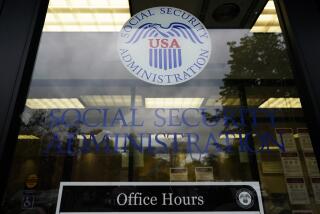Home equity line defaults are likely to rise

- Share via
A wave of potential defaults on home equity lines of credit could start arriving in the next few years as Americans face a day of reckoning on their boom-era borrowing.
Many homeowners who took out home equity lines, essentially second mortgages, during the housing bubble have been paying only interest.
Now, as they are nearing their end-of-draw terms, shutting down further borrowing, they have to start paying back principal along with interest. That, credit rating firm TransUnion said Thursday, could lead to payment shock — and possible defaults.
Economists said that the threat is particularly pronounced in California, especially more affordable inland areas, because of the flood of risky lending that led up to the housing meltdown and the Great Recession.
“The bubble areas are going to have the biggest risk,” said Dean Baker, co-director of the Center for Economic and Policy Research.
Nationwide, $50 billion to $79 billion in home equity lines are at heightened risk for default in coming years, TransUnion said in its study. Borrowers of those loans have lower credit scores, less equity in their homes and less flexibility in adjusting to a sharp rise in expenses, the Chicago firm said.
While the problem is significant, it’s manageable, said Ezra Becker, a TransUnion vice president. Lenders can contact borrowers and try to make arrangements with those most prone to default.
He said the loans with the highest risk are a small segment —11% to 19% — of home equity lines of credit, known as HELOCs, that have balances yet to mature.
“A lot of people are worried that the sky is going to fall,” said Becker, who co-wrote the study. “The numbers indicate the majority of HELOCs are low risk.”
As a wave of borrowers face higher payments in coming years, the larger economic recovery should bolster their ability to weather payment shock, Becker said.
Not only is the job market improving, but home prices have risen sharply in the last two years. That should make it easier for borrowers to refinance or sell their homes if they get into trouble, he said.
Home equity lines of credit enable homeowners to borrow up to a pre-defined amount at their discretion. During last decade’s housing boom, Americans borrowed feverishly against their rising equity, often using the lines to buy cars and take vacations.
A year before the housing meltdown, Richard Peterson took out a $167,000 credit line on his Huntington Beach condo. He didn’t even have to ask. Countrywide Financial Corp., then an aggressive Calabasas home lender, called the insurance adjuster on the phone in 2006 and offered him one.
“They were just giving money out,” Peterson said. “It paid off my car and everything.”
But the lines usually run dry after 10 or 15 years, forcing borrowers to make set payments on the debt monthly or pay the entire amount.
Peterson, 62, who has since retired, received his unpleasant shock last month in a letter from Specialized Loan Servicing, the company that collects his mortgage payment. As of July 2016, his payment will rise to more than $1,100 a month from the $400 he is paying to cover just the interest.
“We both now live on a fixed income and will not be able to make the payments,” he said of himself and his girlfriend.
The U.S. Comptroller of the Currency, which regulates national banks, has been urging bankers for more than two years to help borrowers like Peterson.
Those efforts and routine payoffs of the credit lines have helped reduce the number of borrowers approaching the end-of-the-draw periods at large banks by about 20% from the end of 2011 to the end of 2013, the comptroller said in a June report.
But that still left nearly $150 billion in credit lines subject to higher payment shock from 2015 through 2017 at the nine largest banks regulated by the agency. “While improving, substantial challenges remain, and the OCC will continue to monitor exposure levels and lender efforts to mitigate the risks,” it said.
The banks with the largest exposure to these credit line payment shocks, Wells Fargo & Co., Bank of America Corp. and JPMorgan Chase & Co., said they were aggressively offering to rework or refinance debts, where possible.
At Chase, around $29 billion of the bank’s $49 billion in home equity lines of credit will reset through 2017, mortgage spokesman Jason Lobo said.
Many who have sufficient equity in their homes choose to refinance, Lobo said, wrapping their existing first mortgage and the credit-line debt into a new, longer-term fixed mortgage.
As of June 30, Bank of America had $89.7 billion in outstanding home equity loans and credit lines, the most of all the banks, and Wells Fargo was No. 2 with $80 billion.
Economists said defaults would likely be focused in areas such as the Antelope Valley and the Inland Empire, where many homeowners still owe more than their homes are worth.
But the pain likely won’t go much farther than that. Economists said they don’t foresee HELOC payment shock stalling either the housing or broader economic recovery.
“I don’t see it shaking the financial system,” Baker said. “This isn’t anything like we saw in 2008 and 2009.”
More to Read
Inside the business of entertainment
The Wide Shot brings you news, analysis and insights on everything from streaming wars to production — and what it all means for the future.
You may occasionally receive promotional content from the Los Angeles Times.












